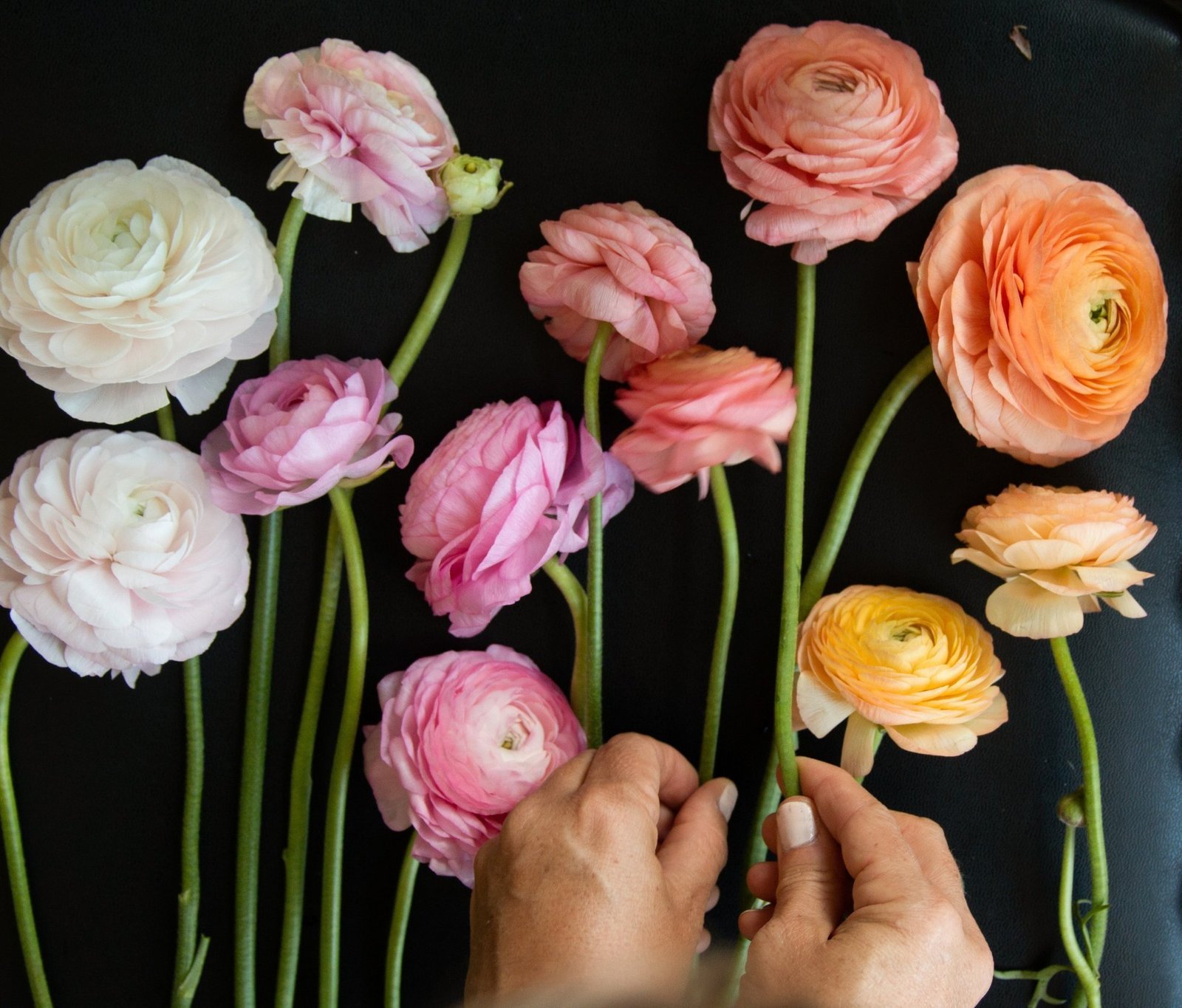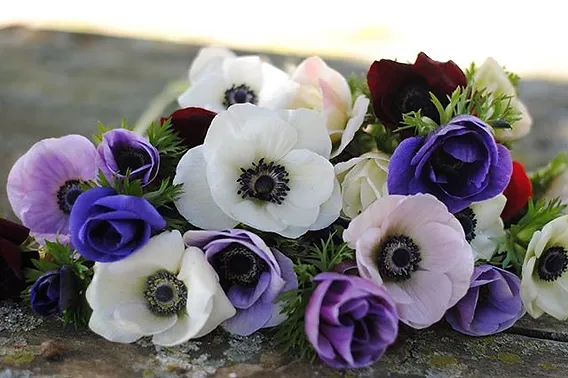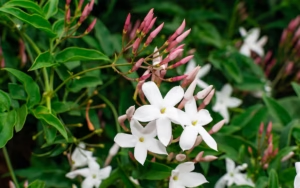Ranunculus flowers are stunning blooms that add charm and elegance to any garden. Known for their vibrant colors and layers of delicate petals, these flowers resemble miniature roses, making them a favorite among gardeners and florists. If you’re looking to add these beauties to your garden, this detailed guide will walk you through everything you need to know. From planting and care to propagation and dealing with pests, we’ll cover it all in a simple, friendly tone to ensure your success.
Ranunculus Overview Table
| Common Name | Ranunculus, Persian Buttercup |
|---|---|
| Botanical Name | Ranunculus asiaticus |
| Family | Ranunculaceae |
| Plant Type | Perennial (often grown as an annual) |
| Mature Size | 12-18 inches tall, 6-12 inches wide |
| Sun Exposure | Full sun |
| Soil Type | Well-draining, fertile, sandy or loamy soil |
| Soil pH | Slightly acidic to neutral (6.0-7.0) |
| Hardiness Zones | 8-11 (grown as annual in colder zones) |
| Native Area | Asia, Southern Europe, Middle East |
| Toxicity | Toxic to humans and pets if ingested |
Ranunculus Care
Growing ranunculus flowers can be a rewarding experience when you understand their needs. These blooms require a bit of attention, but with the right care, they’ll reward you with breathtaking blossoms. Let’s look at the essential care tips for healthy ranunculus plants.
Light Requirements
Ranunculus thrive in full sunlight. For the best results, plant them in a spot that receives at least 6-8 hours of direct sunlight each day. Insufficient light may lead to weaker stems and fewer blooms. If you live in a very hot climate, consider providing some afternoon shade to prevent heat stress.
Soil Preparation
Ranunculus prefer well-draining, fertile soil that retains moisture but doesn’t become waterlogged. A sandy or loamy soil type works best. To improve soil fertility, incorporate organic matter like compost or well-rotted manure before planting.
- Tip: Conduct a soil test to ensure the pH remains between 6.0 and 7.0.
- Drainage: Avoid heavy clay soils. If necessary, use raised beds or add sand and organic matter to improve drainage.
Watering
Proper watering is essential for ranunculus care. Keep the soil moist but not soggy. Overwatering can lead to root rot, so ensure the soil dries slightly between watering sessions. During the blooming season, water more frequently as flowers require extra hydration.
- Tip: Use a soaker hose or water directly at the base to avoid wetting the foliage, which can lead to fungal diseases.
Temperature and Humidity
Ranunculus prefer cool weather. They grow best in temperatures ranging from 50°F to 70°F (10°C to 21°C). In warm climates, plant ranunculus during the fall for a spring bloom. In cooler zones, plant them in early spring.
- Tip: Avoid exposing ranunculus to extreme heat or frost.
Fertilizing
Feed your ranunculus plants with a balanced, water-soluble fertilizer every 2-3 weeks during the growing season. A fertilizer with equal parts nitrogen, phosphorus, and potassium (e.g., 10-10-10) will support healthy growth and blooms.
Mulching
Applying a thin layer of organic mulch can help retain soil moisture and regulate temperature. Mulch also suppresses weeds, which can compete with your ranunculus for nutrients.
Types of Ranunculus
Ranunculus flowers come in various types, offering a wide range of colors and petal shapes. Here are some of the most popular varieties:
1. Persian Buttercup (Ranunculus asiaticus)
This is the most common variety, known for its rose-like flowers in bright shades of red, yellow, pink, orange, and white. Persian Buttercups are perfect for flower beds, borders, and containers.
2. Tecolote Ranunculus
Tecolote ranunculus plants produce large, show-stopping blooms with layers of petals. They are commonly grown for cut flowers and can reach up to 18 inches in height.
3. Cloni Ranunculus
Cloni varieties are prized for their uniform, large flowers and long stems, making them perfect for floral arrangements. These are often grown by professional gardeners.
4. Butterfly Ranunculus
Unlike other ranunculus, butterfly varieties have a delicate, single-layer petal structure with a glossy finish. They bloom profusely and have a wildflower charm.
Each type of ranunculus offers something unique, so choose varieties that match your garden style or floral needs.

Pruning
Pruning is a simple yet crucial step in caring for ranunculus flowers. It helps improve plant health and encourages more blooms.
Deadheading Flowers
Deadheading is the process of removing spent blooms. Regularly deadhead your ranunculus flowers to redirect energy into producing new blooms rather than seeds.
- How to Deadhead: Snip off faded flowers just above the nearest healthy leaf using clean, sharp scissors.
Trimming Yellow Leaves
Remove any yellow or damaged leaves throughout the growing season. This prevents the spread of diseases and pests.
End-of-Season Pruning
Once the blooming period ends and the foliage begins to yellow, cut back the plants to the ground. This step is especially important for gardeners in colder climates who need to prepare the tubers for overwintering.
Propagating Ranunculus
Ranunculus can be propagated through tubers or seeds. Tubers are the most popular method as they yield quicker and more consistent results.
Propagating From Tubers
- Divide Tubers: Carefully dig up the tubers after the growing season. Gently separate the “claw-like” tubers, ensuring each section has a healthy bud.
- Store Tubers: Allow the tubers to dry for a few days in a cool, dark place. Store them in a breathable bag with sawdust or peat moss until the next planting season.
- Replant: Plant the tubers in early spring or fall, depending on your climate.
Propagating From Seeds
Propagating ranunculus from seeds takes more time and effort but is still a rewarding process.
- Sow Seeds Indoors: Start seeds indoors 8-10 weeks before the last frost date.
- Plant in Seed Trays: Fill trays with a seed-starting mix and sprinkle the seeds lightly over the surface. Cover with a thin layer of soil.
- Water and Cover: Keep the soil moist and cover the trays with plastic wrap to maintain humidity.
- Germination: Seeds usually germinate within 2-3 weeks. Once seedlings appear, remove the cover and place them under grow lights.
- Transplant: Once seedlings develop a few sets of true leaves, transplant them into the garden.
How to Grow Ranunculus From Seed
While growing ranunculus from tubers is the norm, starting from seeds can be a fun challenge. Follow these steps for success:
- Prepare Seed Trays: Use trays with good drainage and fill them with seed-starting mix.
- Sow Seeds: Scatter ranunculus seeds evenly and cover with a thin layer of soil.
- Humidity and Warmth: Cover trays with plastic or a humidity dome to keep the environment warm (around 60°F to 70°F).
- Watering: Keep the soil consistently moist but not waterlogged.
- Germination: Wait patiently! Germination takes 2-3 weeks.
- Transplant Outdoors: Harden off seedlings for a week before moving them to a sunny garden spot.
Overwintering
Ranunculus tubers are sensitive to frost, so proper overwintering is essential for colder regions.
- Dig Up Tubers: After the foliage dies back, carefully dig up the tubers.
- Dry and Store: Allow the tubers to dry, then store them in a cool, dark place with good airflow.
- Replant: Replant tubers in early spring or fall, depending on your region.
In warmer zones (8-11), you can leave ranunculus in the ground, but mulch heavily to protect from occasional cold snaps.
Common Pests & Plant Diseases
Pests
Ranunculus flowers are susceptible to a few common garden pests. Here’s how to identify and control them:
- Aphids: These small, sap-sucking insects cluster on stems and leaves, causing distorted growth and yellowing.
- Solution: Use insecticidal soap or a strong blast of water to remove aphids. Introduce natural predators like ladybugs.
- Spider Mites: Tiny mites that cause speckled leaves and fine webbing on the plant.
- Solution: Spray plants with neem oil or insecticidal soap. Keep humidity levels up to deter mites.
- Slugs and Snails: These pests chew holes in leaves and flowers, especially in damp conditions.
- Solution: Use slug baits or traps. Hand-pick slugs in the evening and remove hiding spots like mulch or rocks.
Diseases
Ranunculus can fall victim to fungal diseases, often caused by overwatering or poor air circulation.
- Root Rot: Overwatered plants may develop rotting roots, leading to wilting and eventual death.
- Prevention: Ensure proper drainage and let the soil dry between waterings.
- Powdery Mildew: This fungal disease causes a white, powdery coating on leaves and stems.
- Solution: Apply a fungicide and ensure good airflow around the plants.
- Botrytis Blight (Gray Mold): Appears as gray, fuzzy mold on stems and flowers, especially in humid weather.
- Solution: Remove affected areas and avoid overhead watering. Use fungicides as needed.
By monitoring your plants regularly, you can catch these issues early and keep your ranunculus healthy.
How to Get Ranunculus to Bloom
To enjoy abundant blooms, follow these tips to encourage flowering:
- Plant at the Right Time: Ranunculus bloom best when temperatures remain cool (50–70°F). Plant tubers in fall in warmer regions and early spring in cooler zones.
- Proper Spacing: Space plants 6–12 inches apart to allow airflow and prevent fungal issues.
- Feed Regularly: Use a balanced fertilizer during the growing season to provide essential nutrients for blooming.
- Deadhead Spent Flowers: Regularly remove faded blooms to encourage continuous flower production.
- Adequate Sunlight: Ensure your plants receive at least 6–8 hours of sunlight daily.
If your ranunculus refuses to bloom, check for issues like poor soil drainage, insufficient sunlight, or nutrient deficiencies.
FAQ
1. When should I plant ranunculus tubers?
Plant ranunculus tubers in fall (for warmer climates) or early spring (for cooler climates) to enjoy blooms in spring or summer.
2. How long does it take for ranunculus to bloom?
Ranunculus flowers usually bloom about 90 days after planting tubers, depending on weather and growing conditions.
3. Can ranunculus grow in pots?
Yes! Ranunculus grow well in containers. Use well-draining soil and ensure the pots have good drainage holes.
4. How long do ranunculus flowers last?
Ranunculus blooms last about 4–6 weeks, making them a long-lasting addition to any garden or floral arrangement.
5. Are ranunculus toxic to pets?
Yes, ranunculus plants are toxic to pets and humans if ingested. Keep them out of reach of curious pets and children.
Read also: https://techcrunchs.net/rubber-plant-how-to-grow-and-care-for-rubber-plant/









